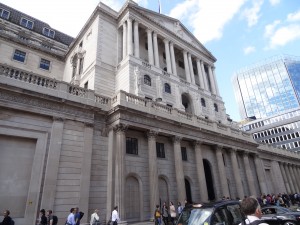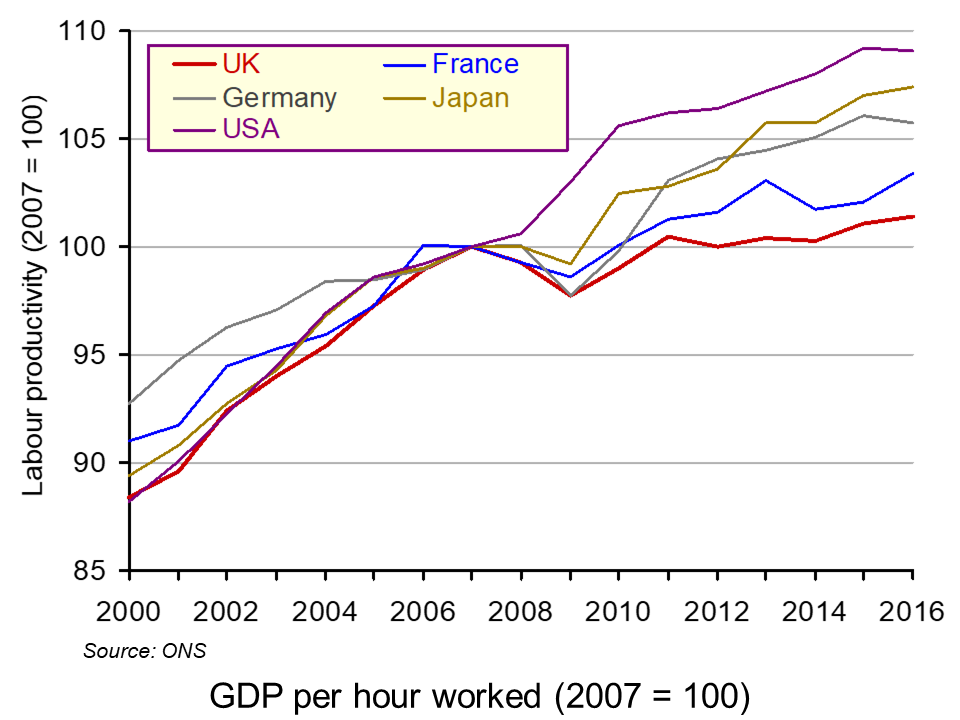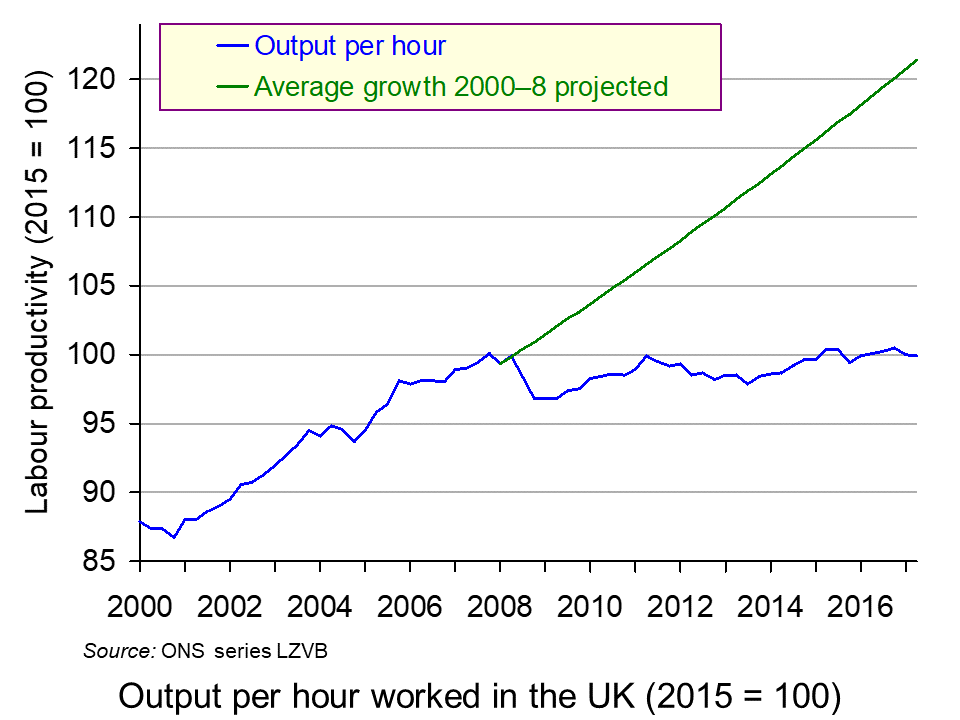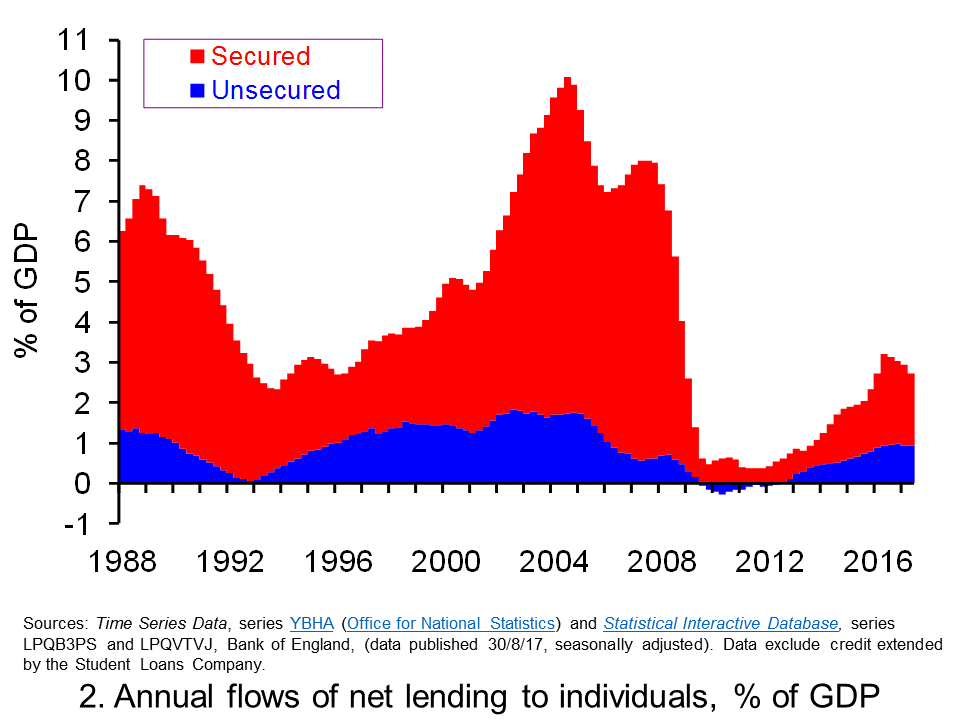 We have reported frequently in our blogs about concerns over rising debt levels among UK households. We previously noted the concerns expressed in July 2014 by the Prudential Regulation Authority (PRA) that the growth in consumer credit (unsecured lending) was stretching the financial well-being of individuals with implications for the resilience of lenders’ credit portfolios. Now the Chief Executive of the Financial Conduct Authority (FCA), Andrew Bailey, in an interview to the BBC has identified the growing problem of debt among young people.
We have reported frequently in our blogs about concerns over rising debt levels among UK households. We previously noted the concerns expressed in July 2014 by the Prudential Regulation Authority (PRA) that the growth in consumer credit (unsecured lending) was stretching the financial well-being of individuals with implications for the resilience of lenders’ credit portfolios. Now the Chief Executive of the Financial Conduct Authority (FCA), Andrew Bailey, in an interview to the BBC has identified the growing problem of debt among young people.
In his interview Mr Bailey stresses that the growth in debt amongst younger people is not ‘reckless borrowing’ and so not borne out of a lack of willpower or ‘present bias’ (see John’s blog Nudging mainstream economists). Rather, it is borrowing simply to meet basic living costs.
In his interview Mr Bailey goes on to identify generational shifts in patterns of wealth and debt. He notes:
There are particular concentrations [of debt] in society, and those concentrations are particularly exposed to some of the forms and practices of high cost debt which we are currently looking at very closely because there are things in there that we don’t like.
There has been a clear shift in the generational pattern of wealth and income, and that translates into a greater indebtedness at a younger age. That reflects lower levels of real income, lower levels of asset ownership. There are quite different generational experiences.
 Mr Bailey goes on to echo concerns expressed back in July by the Prudential Regulation Authority in relation to the growth in consumer credit. The chart illustrates the scale of the accumulation of consumer credit (unsecured lending) across all individuals in the UK. In August 2017 the stock of unsecured debt rose to £203 billion, the highest level since December 2008 when the financial crisis was unfolding. (Click here to download a PowerPoint of the chart).
Mr Bailey goes on to echo concerns expressed back in July by the Prudential Regulation Authority in relation to the growth in consumer credit. The chart illustrates the scale of the accumulation of consumer credit (unsecured lending) across all individuals in the UK. In August 2017 the stock of unsecured debt rose to £203 billion, the highest level since December 2008 when the financial crisis was unfolding. (Click here to download a PowerPoint of the chart).
In concluding his BBC interview, Mr Bailey notes that credit should be available to younger people. Credit helps individuals to ‘smooth income’ and that this is something which is increasingly important with more people having erratic incomes as the gig-economy continues to grow. However, he notes that credit provision needs to be “sustainable”.
BBC Interview
Financial regulator warns of growing debt among young people BBC News (16/10/17)
Articles
Young people are borrowing to cover basic living costs, warns City watchdog Guardian, Julia Kollewe (16/10/17)
Britain’s debt timebomb: FCA urges action over £200bn crisis Guardian, Phillip Inman and Jill Treanor (18/9/17)
FCA warning that young are borrowing to eat shames Britain Independent, James Moore (16/7/17)
Young people are ‘borrowing to cover basic living costs’ and increasing numbers are going bankrupt, warns financial watchdog Daily Mail, Kate Ferguson (6/10/17)
More and more young people are falling into debt – but it’s not their fault Metro, Alex Simpson (20/10/17)
Data
Bankstats (Monetary and Financial Statistics) – Latest Tables Bank of England
Statistical Interactive Database Bank of England
Questions
- What does it mean if people are financially distressed?
- What do you think Mr Bailey means by ‘sustainable credit’?
- In what ways might levels of debt impact on the macroeconomy?
- How does credit help to smooth spending patterns? Why might this be more important with the growth in the gig-economy?
- What is meant by inter-generational fairness?
- Of what relevance are changing patterns in wealth and debt to inter-generational fairness? What factors might be driving these patterns?
- What sort of credit is unsecured credit? How does it differ from secured credit?
- Are there measures that policymakers can take to reduce the likelihood that flows of credit become too excessive?
 The annual Sveriges Riksbank Prize in Economic Sciences in Memory of Alfred Nobel, normally known as the Nobel Prize in Economics, has been awarded 49 times since it was founded in 1969. Many well-known economists have been recipients of the award. This year it had been awarded to Richard Thaler for his research in behavioural economics. The award recognises his work in integrating economics with psychology.
The annual Sveriges Riksbank Prize in Economic Sciences in Memory of Alfred Nobel, normally known as the Nobel Prize in Economics, has been awarded 49 times since it was founded in 1969. Many well-known economists have been recipients of the award. This year it had been awarded to Richard Thaler for his research in behavioural economics. The award recognises his work in integrating economics with psychology.
Richard H. Thaler has incorporated psychologically realistic assumptions into analyses of economic decision-making. By exploring the consequences of limited rationality, social preferences, and lack of self-control, he has shown how these human traits systematically affect individual decisions as well as market outcomes.
In total, Richard Thaler’s contributions have built a bridge between the economic and psychological analyses of individual decision-making. His empirical findings and theoretical insights have been instrumental in creating the new and rapidly expanding field of behavioural economics, which has had a profound impact on many areas of economic research and policy.
Instead of making the assumption that people are rational maximisers, behavioural economists look at how people actually behave and respond to various incentives.
For example, people may be motivated by concepts of fairness and be prepared to make personal sacrifices for the sake of others. Such concepts of fairness tend to depend on the social context in which choices are made and can be influenced by the way choices are framed.
Also people may not weigh up costs and benefits but use simple rules of thumb, or heuristics, when making decisions. This might be an example of rational behaviour when time or information is limited, but the use of such heuristics often becomes engrained in behaviour and the rules become just habit.
People may also suffer from a lack of willpower or ‘present bias’. They may spend more than they can afford because they cannot resist the temptation to have a product. They may overeat because of the short-term pleasure it brings and ignore the long-term effects on their health.
 Understanding how people make choices and the temptations to which they succumb can help policymakers devise incentives to change behaviour to achieve various social goals.
Understanding how people make choices and the temptations to which they succumb can help policymakers devise incentives to change behaviour to achieve various social goals.
One type of incentive is nudging. A well-known example is people’s choice about whether to become an organ donor in the event of their death. If people are required to opt in to such a scheme, they may never get round to doing so. However, if they are required to opt out if they do not want to participate, many more people would thereby be donors and more organs would become available.
Another form of nudge is making desirable things fun. A well-known experiment here was encouraging people to use the stairs rather than the escalator when exiting a subway by making the stairs like a musical keyboard. See here for more examples.
The UK government set up a Behavioural Insights Team – also known as the Nudge Unit (now independent of government) to find ways of encouraging people to behave in their own or society’s best interests.
But it is not just governments which use the insights of behavioural economists such as Thaler. The advertising and marketing industry is always examining the most effective means of influencing behaviour. A classic example is the loss leader, where consumers are tempted into a shop with a special offer and then end up buying more expensive items there rather than elsewhere.
Firms and advertisers know only too well the gains from tempting people to buy items that give them short-term gratification – such as putting chocolate bars by the tills in supermarkets.
 Understanding consumer psychology helps firms to manipulate people’s choices. And such manipulation may not be in our best interests. If we are being persuaded to buy this product or that, are we fully aware of what’s going on and how our tastes are being affected? Would we, by standing back and reflecting, make the same choices as we do on impulse or out of habit?
Understanding consumer psychology helps firms to manipulate people’s choices. And such manipulation may not be in our best interests. If we are being persuaded to buy this product or that, are we fully aware of what’s going on and how our tastes are being affected? Would we, by standing back and reflecting, make the same choices as we do on impulse or out of habit?
And governments too can seek to manipulate people in ways that some may find undesirable. Governments may try to influence us to follow their particular political agenda – as may newspapers. Certainly, during election or referendum campaigns, we are being nudged to vote a particular way.
It is important then for us to understand when we are being nudged or otherwise persuaded. Do we really want to behave in that way? Just as it is important, then, for governments and firms to understand individuals’ behaviour, so too it is important for individuals to understand their own behaviour.
Articles
Richard Thaler’s work demonstrates why economics is hard The Economist, RA (11/10/17)
Nobel in Economics Is Awarded to Richard Thaler The New York Times, Binyamin Appelbaum (9/10/17)
The Making of Richard Thaler’s Economics Nobel The New Yorker, John Cassidy (10/10/17)
Nobel prize in economics awarded to Richard Thaler The Guardian, Richard Partington (10/10/17)
Richard Thaler is a controversial Nobel prize winner – but a deserving one The Guardian, Robert Shiller (11/10/17)
What the mainstreaming of behavioural nudges reveals about neoliberal government The Conversation, Rupert Alcock (17/10/17)
This year’s economics Nobel winner invented a tool that’s both brilliant and undemocratic Vox, Henry Farrell (16/10/17)
How a critic of economics became the disciplines Nobel-winning best friend The Guardian, Tiago Mata and Jack Wright (25/10/17)
Podcast
 How Richard Thaler changed economics BBC, More of Less, Tim Harford (14/10/17)
How Richard Thaler changed economics BBC, More of Less, Tim Harford (14/10/17)
Questions
- For what reasons may individuals not always weigh up the costs and benefits of purchasing an item?
- Give some examples of the use of heuristics in making consumption decisions?
- Is the use of heuristics irrational?
- Explain how people considering that they have behaved fairly is influenced by the social context of their behaviour?
- Find out what is meant by the Dictator Game and how it can challenge the assumption that people behave selfishly. How is the ‘dictator’s’ behaviour affected by the possible payoffs?
- Thaler suggested that Brexit could be an example of behavioural economics in action. Find out what he meant by this. Do you agree?
- Give some examples of ways in which the government can nudge people to persuade them to behave in socially or individually desirable ways.
- Find out what is meant by the ‘endowment effect’ and how it influences people’s valuation of items they own.
- Why may nudging by governments be undemocratic?
 In various blogs, we’ve looked at the UK’s low productivity growth, both relative to other countries and relative to the pre-1998 financial crisis (see, for example, The UK productivity puzzle and Productivity should we be optimistic?). Productivity is what drives long-term economic growth as it determines potential GDP. If long-term growth is seen as desirable, then a fall in productivity represents a serious economic problem.
In various blogs, we’ve looked at the UK’s low productivity growth, both relative to other countries and relative to the pre-1998 financial crisis (see, for example, The UK productivity puzzle and Productivity should we be optimistic?). Productivity is what drives long-term economic growth as it determines potential GDP. If long-term growth is seen as desirable, then a fall in productivity represents a serious economic problem.
Recent data suggest that the problem, if anything, is worse than previously thought and does not seem to be getting better. Productivity is now some 21% below what it would have been had productivity growth continued at the rate experienced in the years before the financial crisis (see second chart below).
In its latest productivity statistics, the ONS reports that labour productivity (in terms of output per hour worked) fell by 0.1% in the second quarter of 2017. This follows a fall of 0.5% in quarter 1. Over the whole year to 2017 Q2, productivity fell by 0.3%.
 Most other major developed countries have much higher productivity than the UK. In 2016, Italy’s productivity was 9.9% higher than the UK’s; the USA’s was 27.9%, France’s was 28.7% and Germany’s was 34.5% higher. What is more, their productivity has grown faster (see chart).
Most other major developed countries have much higher productivity than the UK. In 2016, Italy’s productivity was 9.9% higher than the UK’s; the USA’s was 27.9%, France’s was 28.7% and Germany’s was 34.5% higher. What is more, their productivity has grown faster (see chart).
But what of the future? The Office for Budget responsibility publishes forecasts for productivity growth, but has consistently overestimated it. After predicting several times in the past that UK productivity growth would rise towards its pre-financial crisis trend of around 2% per year, in its October 2017 Forecast evaluation Report it recognises that this was too optimisitic and revises downwards its forecasts for productivity growth for 2017 and beyond.
As the period of historically weak productivity growth lengthens, it seems less plausible to assume that potential and actual productivity growth will recover over the medium term to the extent assumed in our most recent forecasts. Over the past five years, growth in output per hour has averaged 0.2 per cent. This looks set to be a better guide to productivity growth in 2017 than our March forecast of 1.6 per cent.
Looking further ahead, it no longer seems central to assume that productivity growth will recover to the 1.8 per cent we assumed in March 2017 within five years.
 But why has productivity growth not returned to pre-crisis levels? There are five possible explanations.
But why has productivity growth not returned to pre-crisis levels? There are five possible explanations.
The first is that there has been labour hoarding. But with companies hiring more workers, this is unlikely still to be true for most employers.
The second is that very low interest rates have allowed some low-productivity companies to survive, which might otherwise have been driven out of business.
The third is a reluctance of banks to lend for investment. After the financial crisis this was driven by the need for them to repair their balance sheets. Today, it may simply be greater risk aversion than before the financial crisis, especially with the uncertainties surrounding Brexit.
The fourth is a fall in firms’ desire to invest. Although investment has recovered somewhat from the years directly following the financial crisis, it is still lower than might be expected in an economy that is no longer is recession. Indeed, there has been a much slower investment recovery than occurred after previous recessions.
The fifth is greater flexibility in the labour market, which has subdued wages and has allowed firms to respond to higher demand by taking on more relatively low-productivity workers rather than having to invest in human capital or technology.
Whatever the explanation, the solution is for more investment in both technology and in physical and human capital, whether by the private or the public sector. The question is how to stimulate such investment.
Articles
UK productivity lagging well behind G7 peers – ONS Financial Times, Katie Martin (6/10/17)
UK productivity sees further fall BBC News (6/10/17)
UK resigned to endless productivity gloom The Telegraph, Tim Wallace (10/10/17)
UK productivity estimates must be ‘significantly’ lowered, admits OBR The Guardian, Richard Partington and Phillip Inman (10/10/17)
UK productivity growth to remain sluggish, says OBR BBC News (10/10/17)
Official Treasury forecaster slashes UK productivity growth forecast, signalling hole in public finances for November Budget Independent, Ben Chu (10/10/17)
The Guardian view on Britain’s productive forces: they are not working The Guardian, Editorial (10/10/17)
Mind the productivity gap: the story behind sluggish earnings The Telegraph, Anna Isaac (26/10/17)
Data and statistical analysis
Labour productivity: April to June 2017 ONS Statistical Bulletin (6/10/17)
International comparisons of productivity ONS Dataset (6/10/17)
Forecast evaluation report OBR (October 2017)
Questions
- Explain the relationship between labour productivity and potential GDP.
- What is the relationship between actual growth in GDP and labour productivity?
- Why does the UK lag France and Germany more in output per hour than in output per worker, but the USA more in output per worker than in output per hour?
- Is there anything about the UK system of financing investment that results in lower investment than in other developed countries?
- Why are firms reluctant to invest?
- In what ways could public investment increase productivity?
- What measures would you recommend to encourage greater investment and why?
- How do expectations affect the growth in labour productivity?
 Together with Formula 1, tennis is the other sport I love – and my favourite player by far is Rafa!
Together with Formula 1, tennis is the other sport I love – and my favourite player by far is Rafa!
We often apply game theory to various sports and consider how players, teams and individuals can think strategically. One of the big debates in tennis is ‘who is the best ever’ and I argue that Nadal is the greatest, based on a huge range of metrics.
I saw this article in the Economist, providing analysis and comparison between some of the best tennis players. It shows how we can use economic thinking, probability, game theory and analysis to come to something of an answer about who is the greatest, considering the various players’ runs to the title in the Grand Slams. Of course the reason I’m posting this is because according to the Economist, Rafa is the best! And the reasoning is very sound. Enjoy. I certainly did.
Sorry Roger: Rafael Nadal is not just the King of Clay The Economist (13/09/17)
Questions
- What is game theory and why is it useful?
- How does the rating system aim to measure the skill of a tennis champion?
- In this particular scenario, why is it important to use probabilities?
- We can use game theory to think about penalty shoot outs and whether footballers play to the Nash equilibrium. Can we also use the Nash equilibrium when thinking about tennis? (Think about the serve!)
 An economy that becomes dependent on credit can, in turn, become acutely volatile. Too much credit and there exists the potential for financial distress which can result in an economic slowdown as people cut back on spending. Too little credit and the growth in aggregate demand is subdued. Some argue that this is what now faces a financialised economy like the UK. Even it this overstates the significance of credit, there is no doubt that UK credit data is keenly followed by economists and policymakers.
An economy that becomes dependent on credit can, in turn, become acutely volatile. Too much credit and there exists the potential for financial distress which can result in an economic slowdown as people cut back on spending. Too little credit and the growth in aggregate demand is subdued. Some argue that this is what now faces a financialised economy like the UK. Even it this overstates the significance of credit, there is no doubt that UK credit data is keenly followed by economists and policymakers.
Recent rates of credit accumulation by individuals have raised concern. In July 2014 the Prudential Regulation Authority (PRA) of the Bank of England issued a statement voicing its concern that the growth in consumer credit, also known as unsecured lending, was stretching the financial well-being of individuals and that the resilience of lenders’ consumer credit portfolios was therefore reducing.
 Chart 1 illustrates the scale of the flows of both consumer credit (unsecured lending) and mortgages (secured credit) from banks and building societies to individuals. It shows the amount of credit net of repayments lent over the last 12 months. In the 12 months to July 2017 the net accumulation of consumer credit was £18.2 billion while that of secured borrowing was £40.8 billion. Although the 12-month level of consumer credit accumulation was down from its recent peak of £19.2 billion in November 2016, total net lending (including secured lending) to individuals of £59.0 billion was its highest since September 2008. (Click here to download a PowerPoint of the chart).
Chart 1 illustrates the scale of the flows of both consumer credit (unsecured lending) and mortgages (secured credit) from banks and building societies to individuals. It shows the amount of credit net of repayments lent over the last 12 months. In the 12 months to July 2017 the net accumulation of consumer credit was £18.2 billion while that of secured borrowing was £40.8 billion. Although the 12-month level of consumer credit accumulation was down from its recent peak of £19.2 billion in November 2016, total net lending (including secured lending) to individuals of £59.0 billion was its highest since September 2008. (Click here to download a PowerPoint of the chart).
 To help put in context the size of flows of net lending Chart 2 shows the annual flows of consumer credit and secured debt as percentages of GDP. In this case each observation measures net lending over the past four quarters as a percentage of annual GDP. The latest observation is for 2017 Q2 and shows that the annual net flow of consumer credit was equivalent to 0.94 per cent of GDP while that for secured borrowing was 1.78 per cent of GDP. While the flows of consumer credit and secured borrowing as shares of national income have eased a little from their values in the second half of last year, they have not eased significantly. (Click here to download a PowerPoint of the chart).
To help put in context the size of flows of net lending Chart 2 shows the annual flows of consumer credit and secured debt as percentages of GDP. In this case each observation measures net lending over the past four quarters as a percentage of annual GDP. The latest observation is for 2017 Q2 and shows that the annual net flow of consumer credit was equivalent to 0.94 per cent of GDP while that for secured borrowing was 1.78 per cent of GDP. While the flows of consumer credit and secured borrowing as shares of national income have eased a little from their values in the second half of last year, they have not eased significantly. (Click here to download a PowerPoint of the chart).
 Despite the recent strength of borrowing, levels are nothing like those seen in the mid 2000s. Nonetheless, we need to see the current accumulation of debt in the context of two important factors: debt already accumulated and the future macroeconomic environment. Chart 3 gives some insight to the first of these two by looking at stocks of debt outstanding as shares of GDP. The total debt-to-GDP ratio peaked 90 percent in 2009 before relatively slower growth in credit accumulation saw the ratio fall back. The ratio has now been at or around the 78 per cent level consistently for the past two or so years. (Click here to download a PowerPoint of the chart).
Despite the recent strength of borrowing, levels are nothing like those seen in the mid 2000s. Nonetheless, we need to see the current accumulation of debt in the context of two important factors: debt already accumulated and the future macroeconomic environment. Chart 3 gives some insight to the first of these two by looking at stocks of debt outstanding as shares of GDP. The total debt-to-GDP ratio peaked 90 percent in 2009 before relatively slower growth in credit accumulation saw the ratio fall back. The ratio has now been at or around the 78 per cent level consistently for the past two or so years. (Click here to download a PowerPoint of the chart).
The ratio of the stock of consumer debt to GDP peaked in 2008 at 13.3 per cent. It too fell back reaching 9.05 per cent in the middle of 2014. Since that time the ratio has been rising and by the end of the second quarter of this year was 10.1 per cent. The PRA appears not only to be concerned by this but also the likely unwinding of what it describes as the ‘current benign macroeconomic environment and historically low arrears rates’.
Going forward, we might expect to see ever closer scrutiny not only of the aggregate indicators referred to here but of an array of credit indicators. The PRA statement, for example, refers to the number of , ‘0% interest credit card offers’, falling interest rates on unsecured personal loans and the growth of motor finance loans. The hope is that we can avoid the costs of financial distress that so starkly affected the economy in the late 2000s and that continue to cast a shadow over today’s economic prospects.
PRA Statement
PRA Statement on Consumer Credit PRA, Bank of England (4/7/14)
Articles
Bank of England demands consumer credit vigilance; construction growth slows – as it happened Guardian (4/7/14)
Bank of England warns more defences may be needed against consumer credit Telegraph (24/7/17)
Beware the bubble: Bank of England clamps down on credit Telegraph, Tim Wallace (1/7/17)
Bank of England raises capital requirements on UK lenders amid concerns about excessive consumer borrowing Independent, Ben Chu (27/6/17)
Bank of England tightens mortgage borrowing rules amid fears of debt boom Express, Lana Clements (27/6/17)
Rise in personal loans dangerous, Bank of England official says BBC News (25/7/17)
Bank of England takes action over bad loans BBC News (27/6/17)
Data
Bankstats (Monetary and Financial Statistics) – Latest Tables Bank of England
Statistical Interactive Database Bank of England
Questions
- What does it mean if people are financially distressed? What responses might people take in response to this distress?
- How can financial distress affect the economy’s growth path?
- How would you measure the financial well-being of an individual? What about the financial well-being of firms?
- What role mights banks play in affecting levels of financial distress in the economy?
- What does it mean if credit conditions are pro-cyclical?
- Why might banks’ lending be pro-cyclical?
- Are there measures that policymakers can take to reduce the likelihood that flows of credit become too excessive?
- Why do some economists refer to the economic downturn of the late 2000s as a balance sheet recession? How likely is another balance sheet recession in the short term? What about in the longer term?
 We have reported frequently in our blogs about concerns over rising debt levels among UK households. We previously noted the concerns expressed in July 2014 by the Prudential Regulation Authority (PRA) that the growth in consumer credit (unsecured lending) was stretching the financial well-being of individuals with implications for the resilience of lenders’ credit portfolios. Now the Chief Executive of the Financial Conduct Authority (FCA), Andrew Bailey, in an interview to the BBC has identified the growing problem of debt among young people.
We have reported frequently in our blogs about concerns over rising debt levels among UK households. We previously noted the concerns expressed in July 2014 by the Prudential Regulation Authority (PRA) that the growth in consumer credit (unsecured lending) was stretching the financial well-being of individuals with implications for the resilience of lenders’ credit portfolios. Now the Chief Executive of the Financial Conduct Authority (FCA), Andrew Bailey, in an interview to the BBC has identified the growing problem of debt among young people. Mr Bailey goes on to echo concerns expressed back in July by the Prudential Regulation Authority in relation to the growth in consumer credit. The chart illustrates the scale of the accumulation of consumer credit (unsecured lending) across all individuals in the UK. In August 2017 the stock of unsecured debt rose to £203 billion, the highest level since December 2008 when the financial crisis was unfolding. (Click here to download a PowerPoint of the chart).
Mr Bailey goes on to echo concerns expressed back in July by the Prudential Regulation Authority in relation to the growth in consumer credit. The chart illustrates the scale of the accumulation of consumer credit (unsecured lending) across all individuals in the UK. In August 2017 the stock of unsecured debt rose to £203 billion, the highest level since December 2008 when the financial crisis was unfolding. (Click here to download a PowerPoint of the chart).













